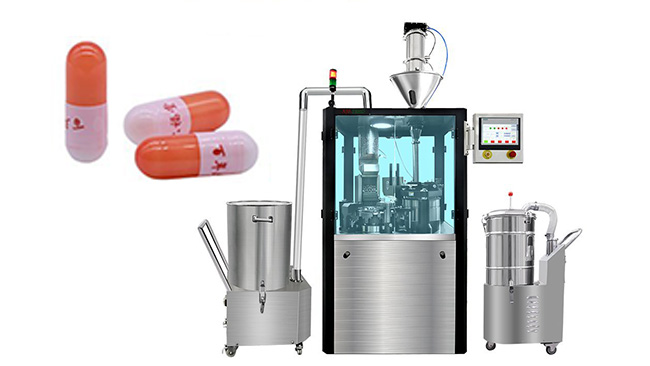If you buy equipment for nutraceutical manufacturing, you juggle fast-changing SKUs, tight deadlines, tricky powders, rigorous audits, and fixed budgets. The right capsule filling machine is not the one that claims the highest brochure speed; it is the one that sustains stable throughput, holds weight targets, shortens changeovers, simplifies cleaning, preserves traceability, and keeps total cost of ownership under control on your real powders and in your real rooms. This article explains how to match formulations to process, what to look for inside an automatic capsule filler machine, which models fit which buyers, and how to approve a line with a minimal acceptance checklist.

Because formulas behave differently, you should select the operating method first and negotiate speed afterward.
For probiotics and enzymes, which are low in bulk density and sensitive to moisture and heat, it is best to run at a low RH setpoint (commonly 30–40% RH), use gentle dosing, minimize exposure time, and prefer HPMC shells. Botanical extracts such as turmeric or ashwagandha are cohesive, dusty, and prone to static, so you stabilize dosing with multi-tamp dosing, install targeted dust extraction at the dosing zone, and support the hopper with vibration or anti-bridging while validating any flow aids for compatibility.Mineral fills like magnesium citrate are heavy and abrasive; they typically perform best on multi-tamp dosing with wear-resistant parts, and you should track disc and pin wear within a defined spares plan. Amino, caffeine, and other nootropic micro-dose blends segregate easily, so a dosator micro-dosing setup, combined with frequent in-process checks and simple control charts, helps prevent drift and chronic over-fill. When encapsulating oils or semi-solids in hard capsules, leakage becomes the primary risk; a liquid module with temperature control paired with or an inner plug, supported by routine leak testing, keeps complaints and rework low.
Shell choice also influences stability and yield. HPMC tolerates lower humidity but can become brittle in very dry rooms, whereas gelatin can become tacky in warm or humid conditions; therefore, machines that offer adjustable vacuum separation and gentle separation mechanics allow both shell types to run reliably.
A dependable system starts with feeding, orientation, and separation. When a stable hopper and orienter are combined with adjustable vacuum separation, rim cracks and jams on HPMC at low RH are reduced significantly. Dosing modules determine most of your accuracy and uptime. The approach gives broad adaptability and high speed that suits botanicals and minerals, while a dosator micro-dosing station provides depth-controlled accuracy for fine or hygroscopic blends. If you require combination fills, pellet or micro-tablet kits perform well as long as the feeder limits segregation; liquid and semi-solid stations, meanwhile, need a pump and nozzle with temperature control and usually pair with liquid hard capsule banding or an inner plug.
Downstream controls are just as important. Closing and rejection stations must hold a consistent lock height and automatically remove under-fills, damaged bodies, or missing caps. To keep the line clean, you should place targeted dust extraction where powder becomes airborne and use de-aeration to stabilize bulk density. On the data side, you will want recipe management, role-based access, a searchable audit trail, e-signatures, and dependable export to QMS, MES, or eBR integration. Finally, tool-less change parts with etched IDs and a photo-based line-clearance SOP make allergen rotations and cleaning fast and repeatable.
Manual systems are appropriate for labs and pilot runs but are not intended for continuous commercial production. Semi-automatic units make sense for small or medium batches or volatile schedules because they keep CAPEX low and offer flexibility, although their throughput still depends partly on operator rhythm, which is why a semi-automatic capsule filler can be a pragmatic choice at this scale. A fully automatic capsule filling machine—fits stable, high-volume programs where OEE and weight control matter most; while CAPEX is higher, the return comes from superior consistency.
For oils and suspensions, a liquid hard-caps model is essential when paired with or an inner plug and a realistic cleaning-validation plan. Where powders are highly potent, allergenic, or extremely dusty, you should consider with negative pressure so both personnel and product remain protected.
| Configuration | Best for | Why choose it | Watch-outs |
|---|---|---|---|
| Manual | R&D, pilot runs | Lowest CAPEX, simple | Not for continuous production |
|
Semi-automatic capsule filler |
Small/medium batches, volatile demand | Flexible, cost-effective | Throughput tied to operators |
| Fully automatic capsule filling machine
|
Stable high volume, tight weights | Highest OEE/consistency | Higher CAPEX; disciplined PM |
| Liquid hard-caps + banding | Oils/suspensions | Controls leakage complaints | Cleaning validation complexity |
|
contained capsule filling systems |
Potent/allergen/dusty powders | Protects people & product | Airflow design cost |

When probiotic potency is at risk, a low-humidity interlock combined with gentle dosing protects label claims and reduces complaints. Dusty botanical runs benefit from targeted dust extraction and de-aeration, which raise OEE and reduce cleaning hours. If you struggle with micro-dose drift and chronic giveaway, a station supported by IPC control charts lowers over-fill and increases first-pass yield. HPMC rim cracks and jams decline markedly when adjustable vacuum separation and gentle separation mechanics are in place, lowering scrap and stabilizing line speed. You can shorten slow changeovers by adopting tool-less quick-change parts and enforcing a , which boosts shift output and improves delivery reliability. Finally, audit pressure eases when you implement with robust user roles, a defensible audit trail, and e-signatures, because review cycles become shorter and risk is reduced.
Your goal is to convert real run-ability and maintainability into black-and-white acceptance rather than leaning on spec-sheet promises. During FAT or SAT, ask the vendor to run your worst powder, your target capsule size, and a realistic commercial speed, and then request a one-page summary that includes the sustainable speed, a weight-trend screenshot, and a breakdown of defect types and ratios. For the same lot, collect the full weight distribution and the defect log, and accept any capability evidence that demonstrates controlled variability.
On changeovers and cleaning, time one complete changeover onsite and verify that the photo-based line-clearance SOP is practical, retaining first-pass swab and visual records in the acceptance pack and aligning them with a cleaning validation checklist. For data and traceability, watch a live demonstration of user roles, the audit trail, and e-signatures, and export a sample file that your QMS, MES, or eBR integration can retain without rework. Finally, ensure the service commitment stands behind the operation by contracting the critical spares list, parts lead times, response time, and the training plan with remedies; a standardized service & spares SLA page helps you align vendors. As a practical tip, agree on numeric thresholds—such as speed, defect share, or changeover minutes—in the contract and accept the machine against those targets rather than publishing one-size-fits-all numbers.
|
Area |
What to see in FAT/SAT |
Deliverable for sign-off |
|
Performance |
Worst powder × target size × commercial speed |
1-page: stable speed, weight trend, defect breakdown |
|
Quality |
Same-lot weight distribution + defect log |
Evidence variability is controlled (charts/summary) |
|
Changeover/cleaning |
Timed changeover + photo-based line-clearance SOP |
First-pass swab & visual records |
|
Data & traceability |
Live demo: roles, audit trail, e-signatures |
Export sample for QMS/MES/eBR integration |
|
Service & spares |
Critical spares, lead times, response time, training |
Contracted service & spares SLA with remedies |
For decision meetings, keep the story compact and visual. Demonstrate sustainable speed using your powders and sizes, prove with simple trends and distributions that weight consistency and defects are under control, and confirm that measured changeover time meets the contractual goal. Track HPMC cracks and jams with logs and document the methods that prevent recurrences, and record environment setpoints with appropriate alarms or interlocks. For a quick financial view, compute effective output as nameplate speed multiplied by performance, availability, and quality; then calculate monthly gain as the change in effective output times unit margin minus incremental costs, and compare that number with CAPEX to estimate payback.
In nutraceuticals, an automatic capsule filler machine proves its worth on your powders at your humidity rather than on a generic demo. Validate the worst-case formula at your target RH before you negotiate speed and price. Convert changeovers, cleaning, and sampling into a photo-based line-clearance SOP and write data traceability alongside the SLA into the contract. When you partner with a proven capsule filling machine manufacturer like Rich Packing, you spend less time fighting variability and more time delivering capacity, consistency, and audit-ready records.
●U.S. FDA — 21 CFR Part 111 (Dietary Supplements cGMP):
https://www.ecfr.gov/current/title-21/chapter-I/subchapter-B/part-111
●U.S. FDA — 21 CFR Part 11 (Electronic Records/E-Signatures):
https://www.ecfr.gov/current/title-21/chapter-I/subchapter-A/part-11
●ICH Q9(R1) Quality Risk Management (Step 4, official PDF)
●USP–NF General Chapters—Dosage Forms